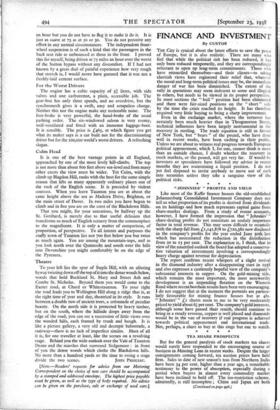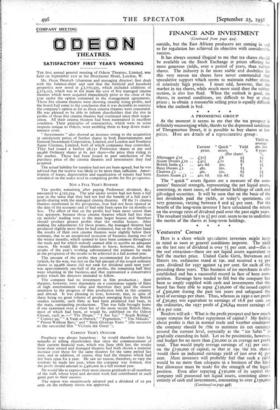FINANCE AND INVESTMENT
By CUSTOS
THE City is cynical about the latest efforts to save the peace of Europe, but it is also realistic. There are many who feel that while the political risk has been reduced, it has only been reduced temporarily, and they are correspondingly reluctant to open up long-term commitments. Those who have reconciled themselves—and their clients—to taking shortish views have registered their relief that, whatever the moral and long-term political issues may be, the immediate danger of war has been diminished. The extent of the rally in quotations may seem indecent to some and illogical to others, but needs to be viewed in its proper perspective. In most sections the " bull " position had been eliminated and there were fair-sized positions on the " short " side by the time the crisis reached its height. It has therefore required very little buying to bring a sharp improvement.
Even in the exchange market, where the turnover has certainly been much heavier than in Throgmorton Street, technical influences have been largely instrumental in the recovery in sterling. The trade equation is still in favour of New York, but " bears " of the pound, who have done well in recent weeks, have been cashing in their profits. Unless we are about to witness real progress towards European political appeasement, which I, for one, cannot think is more than an outside chance, I doubt whether the recovery in stock markets, or the pound, will get very far. If would-bz investors or speculators have followed my advice in recent months they are maintaining a liquid position. I do not yet feel disposed to invite anybody to move out of cash into securities unless they take a sanguine view of the political risks.
* * * *
"JOHNNIES' " PROFITS AND YIELD Like most of the Kaffir finance houses the old-established Johannesburg Consolidated Investment Company does not tell us what proportion of its profits is derived from dividends on its holdings and how much represents capital gains from share-market dealings. From a study of recent accounts, however, I have formed the impression that " Johnnies' " share-dealing profits do not constitute an unduly important factor in total revenue. This may seem difficult to reconcile with the sharp fall from £1,141,878 to £720,380 now disclosed in the company's profits for the year ended June 30th last which has necessitated the reduction in the distribution from 20 to 15 per cent. The explanation is, I think, that in view of the unsettled outlook the board has adopted a conserva- tive valuation of investments involving a correspondingly heavy charge against revenue for depreciation.
The report confirms recent whispers of a slight revival in the diamond industry after a disappointing start in 1938 and also expresses a cautiously hopeful view of the company's substantial interests in copper. On the gold-mining side, which remains the most important, the most noteworthy development is an impending flotation on the Western Rand where recent borehole results have been very encouraging. I do not suggest that at the moment the portents are particu- larly favourable for mining finance houses but at 48s. " Jolumies' " £i shares seem to me to be very moderately priced to yield about k per cent. The company's gold interests, although some have passed their zenith, should continue to bring in a steady revenue, copper is well placed and diamonds would be in the van of recovery if real progress is achieved towards political appeasement and international trade. Not, perhaps, a share to buy at this stage but one to watch. * * * * TEA SHARE PROSPECTS But for the general paralysis of stock markets tea shares would surely have responded to the encouraging course of business in Mincing Lane in recent weeks. Despite the larger consignments coming forward, tea auction prices have held firm. Sales to date of new season's teas from Northern India have been 34 per cent. higher than a year ago, a remarkable testimony to the power of absorption, especially during a period when buyers in almost every commodity market have been inclined to hold off. The tea-restriction scheme, admittedly, is still incomplete ; China and Japan are both
(Continued on page 496.)
FINANCE AND INVESTMENT
(Continued from page 494)
outside, but the East African producers 'are coming in and so far regulation has achieved its objective with considerable success.
It has always seemed illogical to me that tea shares should be available on the Stock Exchange at prices offering far more generous yields, over a period of years, than rubber shares. The industry is far more stable and doubtless for this very reason tea shares have never commanded that speculative support which seems to maintain rubber shares at relatively high prices. I must add, however, that the market in tea shares, while much more staid than ;he rubber section, is also less fluid. When the outlook is good, tea shares, in normal conditions, are difficult to buy at close prices ; to obtain a reasonable selling price is equally difficult when the outlook is bad.
* * * *
A PROMISING GROUP
At the moment it seems to me that the tea prospect is definitely encouraging while, thanks to the depressed condition of Throgmorton Street, it is possible to buy shares at low prices. Here are details of a representative group : Allynugger
Assam Dooars British. India Li . Buxa Dooars £i Chubwa Eastern Assam £i .. Current price.
LL 43111
42s. 6d.
46s.
46s. 41s. Ed.
" Quick " Yield assets. % (Per share) L8 91
Lit 81
3os. 8 20S. 81 22S. 81 13s. 6d. 81 Yield on average div. last 8 years /0 51 5A 51 5 51 51
The " quick " assets figures are a measure of the com- panies' financial strength, representing the net liquid assets, consisting, in most cases, of substantial holdings of cash and gilt-edged securities. It will be seen that on the basis of the last dividends paid the yields, at today's quotations, are very generous, varying between 8 and 91 per cent. For the benefit of the long-term investor I have calculated the return on the average rates of dividend paid over the past eight years. The resultant yields of 5 to 51 per cent. seem to me to underline the merits of the shares as long-term holdings. * * * *
Venturers' Corner
Here is a share which spezulative investors might keep in mind as soon as general conditions improve. The yield on the last rate of dividend is over 71 per cent. and—this is the real attraction—there are net liquid assets equivalent to half the market price. United Carlo Gatti, Stevenson and Slaters los. ordinaries stand, at 19s. and received a 15 per cent. dividend for 1937 against 14 per cent. for each of the preceding three years. This business of ice merchants is old- established and has a successful record in face of keen com- petition. Earnings have tended to fall but the company has been so amply supplied with cash and investments that the board has been able to repay L15o,00o of the issued capital of £300,000 during the past ten years and safeguard the level of earnings per share. Thus, whereas in 1930 a net profit of £50,995 was equivalent to earnings of 16.8 per cent.. on the ordinaries, the 1937 profit of £26,844 meant earnings of 18.9 per cent.
Readers will ask : What is the profit prospect and how much scope remains for further repayment of capital ? My feeling about profits is that in normal trade and weather conditions the company should be able to maintain its net earnings around the current level, especially as the " ice habit " is gradually extending its hold. Let us be pessimistic, however, and budget for no more than £20,000 as an average net profit total. That would imply average earnings of 131 per ceir on the £1 50,000 of capital, so that at 19s. the los. shares would show an indicated earnings yield of just over 6i per cent. Most investors will probably' feel that such a yield would be no more than adequate in a business of this kind but allowance must be made'for the strength of the liquid position. Even after repaying L150,000 of its capital th company still possessed net -liquid assets, consisting almost entirely of cash and investments, amounting to over £15o,oco
(Continued on page 498)
FINANCE AND INVESTMENT (Continued from page 496.) at December 31st last. Obviously, the board is in a position, if it thinks fit, to repay a further 5s. per share, which would involve a sum of £75,000, at any time and still leave the com- pany well supplied with liquid resources. If this were done, buyers at today's price would, in effect, be paying 14s. for what would become a 5s. share, while the indicated earnings per share, on our k20,000 estimate, would be doubled at 263 per cent. The earnings yield would be increased to the generous figure of nearly to per cent.








































 Previous page
Previous page